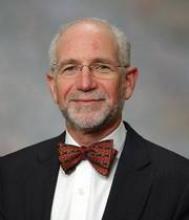A proposal for a new way to classify seizures would modify the way they have been discussed and organized since 1989.
But the new system – put forth by a committee specially convened by the International League Against Epilepsy (ILAE) – isn’t finding friends in every corner. Its move away from expert opinion to clinical evidence has ruffled the feathers of some highly respected clinicians, who assert that the current system is well organized, logical, and has long been integrated into both education and practice.
The proposed classification and terminology scheme would follow a Darwinian-like "Tree of Life" organization. Seizures would be broadly grouped into generalized or focal, depending on their origin and propagation over hemispheres; etiology (structural/metabolic, genetic, or unknown); and finally, by diagnostic specificity.
In this new scheme, focal seizures are seen as those that originate within a neuronal network but are limited to one hemisphere. Seizures that rapidly activate bilateral neuronal networks are seen as generalized.
Generalized seizures could be further categorized by their clinical presentation (tonic, clonic, or a combination; atonic; myoclonic; or absence), age at manifestation, and into other symptoms (Epilepsia 2010;51:676-85).
The system also advises dropping some terms that could be confusing or emotionally charged. "Benign" doesn’t recognize that real problems may result from the condition, wrote primary author Anne T. Berg, Ph.D. Both "idiopathic" and "cryptogenic" can now mean "unknown cause," but can also designate highly drug responsive, or symptomatic. "Symptomatic" currently connotes a poor prognosis, while ignoring the concept that all seizures cause symptoms, she wrote in the document.
"In addition to being confusing, these current terms aren’t necessarily true," said Dr. Jeffrey R. Buchhalter, who was a member of the classification writing committee and is a pediatric neurologist at the Phoenix Children’s Hospital. "What this new system is all about is separating what we know is true from what we do not."
The proposed system doesn’t replace diagnostic classifications, Dr. Berg, a research professor at Northwestern University, Chicago, said in an interview.
A diagnosis can be made with the existing terms, like Lennox-Gastaut syndrome or childhood absence epilepsy. Instead, the proposed system attempts to logically organize them according to their fundamental relationships.
"What we propose looks at the individual pieces [of the disorders] separately and then asks ‘How often do these go together?’ The new system would also benefit research, because everyone – no matter what country – would be speaking the same scientific language, she added.
The committee’s proposal is based on scientific evidence, instead of relying heavily on expert opinion, as does the current scheme, which was created in 1989. The current system doesn’t allow for the enormous changes made in understanding what causes epilepsy and how it is best treated, Dr. Hans Luders said in an interview. Any descriptive method needs to include these advances in imaging, genetics, and pharmacotherapy. The new system incorporates those new understandings, but in doing so, it drops some cherished nomenclature.
"What we have now, in many cases, are named syndromes used as diagnostic labels," said Dr. Luders, a neurologist at Case Western Reserve University, Cleveland. "Syndromes are a constellation of clinical signs that tend to uniformly occur together. As we have become more sophisticated, what is a syndrome or not has become debatable. There are so many syndromes now that memorizing them has become quite confusing," both for neurologists and students.
"We’re moving away from consensus opinion of thought leaders, and from whom consensus opinion was derived, to evidence-based ideas. And in any evidence review, expert opinion is the lowest tier. It’s below level 4," Dr. Berg said.
As such, the new proposal is not without its detractors, she said. A March opinion piece in Epilepsia airs some of these issues (Epilepsia 2012;53:399-404). In it, Dr. Chrysostomos P. Panayiotopoulos argues that the proposed classification scheme "does not fulfill its intent to improve the [current] classifications."
Dr. Panayiotopoulos, a neurologist at the John Radcliffe Hospital in Headington, England, is also the first to have described Panayiotopoulos syndrome, a benign childhood epilepsy characterized by autonomic seizures and status epilepticus, and a shifting or multifocal electroencephalogram.
The new classification scheme "has met with considerable protest from several expert epileptologists" and doesn’t incorporate most of the classification changes suggested in the 2010 ILAE report, he wrote. But philosophical arguing hobbled that proposed system, and it was never actually adopted by the ILAE. Because of the field’s inability to agree on the 2010 document, much of the extant classification system is still the same as it was in 1989.



